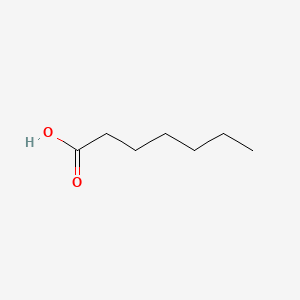| MeSH term | MeSH ID | Detail |
|---|---|---|
| Byssinosis | D002095 | 11 associated lipids |
| Olfaction Disorders | D000857 | 17 associated lipids |
| Mitochondrial Diseases | D028361 | 25 associated lipids |
HEPTANOIC ACID
HEPTANOIC ACID is a lipid of Fatty Acyls (FA) class. Heptanoic acid is associated with abnormalities such as Dehydration. The involved functions are known as Process, Anabolism, inhibitors, Oxidation and fatty acid oxidation. The related lipids are Heptanoates and undecanoic acid.
Cross Reference
Introduction
To understand associated biological information of HEPTANOIC ACID, we collected biological information of abnormalities, associated pathways, cellular/molecular locations, biological functions, related genes/proteins, lipids and common seen animal/experimental models with organized paragraphs from literatures.
What diseases are associated with HEPTANOIC ACID?
HEPTANOIC ACID is suspected in Dehydration and other diseases in descending order of the highest number of associated sentences.
Related references are mostly published in these journals:
| Disease | Cross reference | Weighted score | Related literature |
|---|
Possible diseases from mapped MeSH terms on references
We collected disease MeSH terms mapped to the references associated with HEPTANOIC ACID
PubChem Associated disorders and diseases
What pathways are associated with HEPTANOIC ACID
There are no associated biomedical information in the current reference collection.
PubChem Biomolecular Interactions and Pathways
Link to PubChem Biomolecular Interactions and PathwaysWhat cellular locations are associated with HEPTANOIC ACID?
There are no associated biomedical information in the current reference collection.
What functions are associated with HEPTANOIC ACID?
Related references are published most in these journals:
| Function | Cross reference | Weighted score | Related literatures |
|---|
What lipids are associated with HEPTANOIC ACID?
Related references are published most in these journals:
| Lipid concept | Cross reference | Weighted score | Related literatures |
|---|
What genes are associated with HEPTANOIC ACID?
There are no associated biomedical information in the current reference collection.
What common seen animal models are associated with HEPTANOIC ACID?
There are no associated biomedical information in the current reference collection.
NCBI Entrez Crosslinks
All references with HEPTANOIC ACID
Download all related citations| Authors | Title | Published | Journal | PubMed Link |
|---|---|---|---|---|
| Chen CN et al. | A probable aculeacin A acylase from the Ralstonia solanacearum GMI1000 is N-acyl-homoserine lactone acylase with quorum-quenching activity. | 2009 | BMC Microbiol. | pmid:19426552 |
| Le Leu RK et al. | Effect of high amylose maize starches on colonic fermentation and apoptotic response to DNA-damage in the colon of rats. | 2009 | Nutr Metab (Lond) | pmid:19267935 |
| Serra O et al. | Silencing of StKCS6 in potato periderm leads to reduced chain lengths of suberin and wax compounds and increased peridermal transpiration. | 2009 | J. Exp. Bot. | pmid:19112170 |
| Spring S et al. | The photosynthetic apparatus and its regulation in the aerobic gammaproteobacterium Congregibacter litoralis gen. nov., sp. nov. | 2009 | PLoS ONE | pmid:19287491 |
| Titus SA et al. | A new homogeneous high-throughput screening assay for profiling compound activity on the human ether-a-go-go-related gene channel. | 2009 | Anal. Biochem. | pmid:19583963 |
| Bignetti E et al. | The amelioration of olfactory acuity upon sexual maturation might affect food preferences. | 2009 | Nutrients | pmid:22253964 |
| Januszkiewicz J et al. | Optimization of headspace solid-phase microextraction for the analysis of specific flavors in enzyme modified and natural Cheddar cheese using factorial design and response surface methodology. | 2008 | J Chromatogr A | pmid:18495140 |
| Du XL et al. | 6-Oxy-(acetyl ethylenediamine) fluorescein, a novel fluorescent derivatization reagent for carboxylic acids and its application in HPLC. | 2008 | J Sep Sci | pmid:18381692 |
| Zarzycki PK and Zarzycka MB | Application of temperature-controlled micro planar chromatography for separation and quantification of testosterone and its derivatives. | 2008 | Anal Bioanal Chem | pmid:18338160 |
| Du XL et al. | Design and synthesis of a novel fluorescent reagent, 6-oxy-(ethylpiperazine)-9-(2'-methoxycarbonyl) fluorescein, for carboxylic acids and its application in food samples using high-performance liquid chromatography. | 2008 | J Chromatogr A | pmid:18067902 |
| Khenkin AM and Neumann R | Oxidative C-C bond cleavage of primary alcohols and vicinal diols catalyzed by H5PV2Mo10O40 by an electron transfer and oxygen transfer reaction mechanism. | 2008 | J. Am. Chem. Soc. | pmid:18841966 |
| Wang C et al. | Validation of a testosterone and dihydrotestosterone liquid chromatography tandem mass spectrometry assay: Interference and comparison with established methods. | 2008 | Steroids | pmid:18579171 |
| Rainer MK | Risperidone long-acting injection: a review of its long term safety and efficacy. | 2008 | Neuropsychiatr Dis Treat | pmid:19183782 |
| Narayanan R et al. | Selective androgen receptor modulators in preclinical and clinical development. | 2008 | Nucl Recept Signal | pmid:19079612 |
| Samaha AA et al. | Multi-organ damage induced by anabolic steroid supplements: a case report and literature review. | 2008 | J Med Case Rep | pmid:18976461 |
| McGrath KC et al. | Androgen therapy and atherosclerotic cardiovascular disease. | 2008 | Vasc Health Risk Manag | pmid:18629352 |
| Taylor RA and Ellis HA | Anhydrous polymeric zinc(II) penta-noate. | 2008 | Acta Crystallogr Sect E Struct Rep Online | pmid:21202761 |
| González R et al. | Use of a neuroleptic in assisted reproduction of the critically endangered Mohor gazelle (Gazella dama mhorr). | 2008 | Theriogenology | pmid:18606442 |
| Wei J et al. | Plants attract parasitic wasps to defend themselves against insect pests by releasing hexenol. | 2007 | PLoS ONE | pmid:17786223 |
| Olfson M et al. | Treatment of schizophrenia with long-acting fluphenazine, haloperidol, or risperidone. | 2007 | Schizophr Bull | pmid:17470444 |
